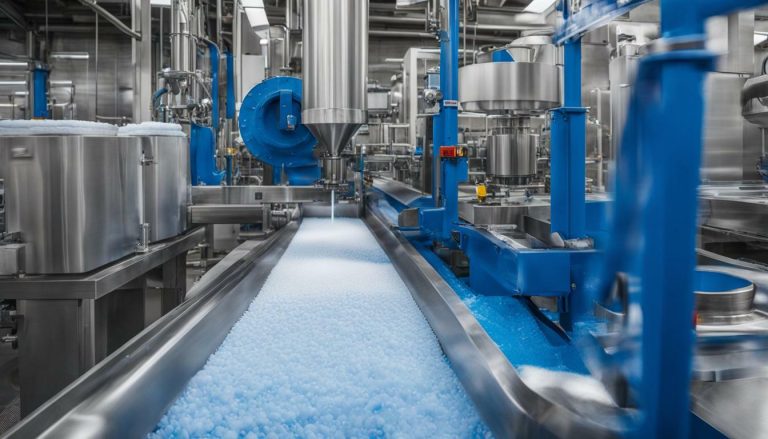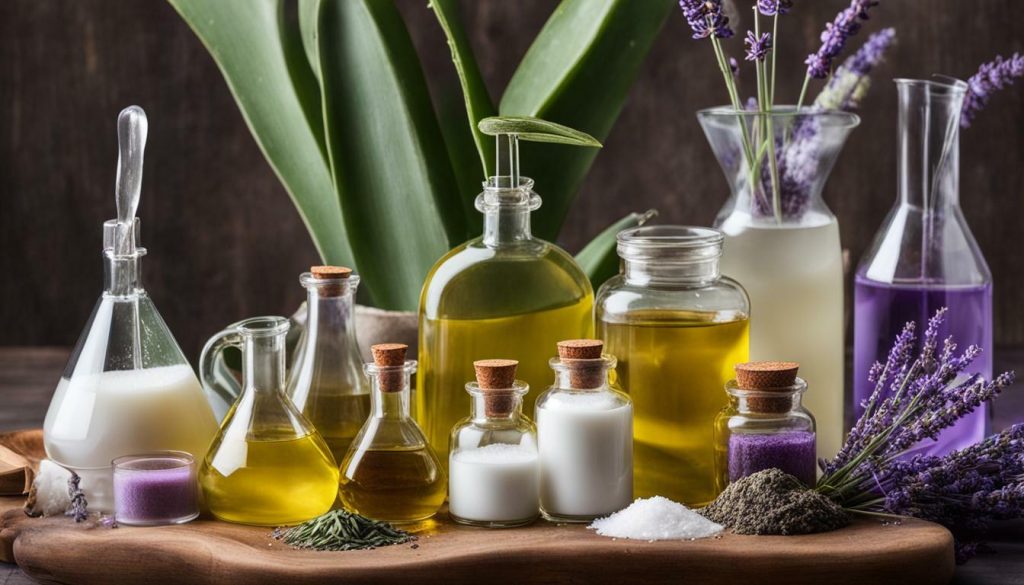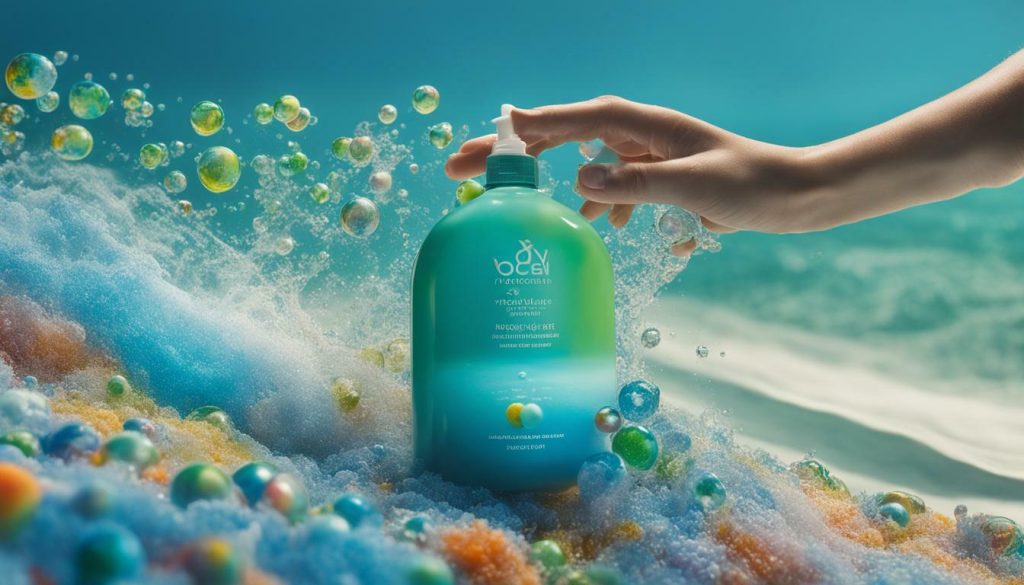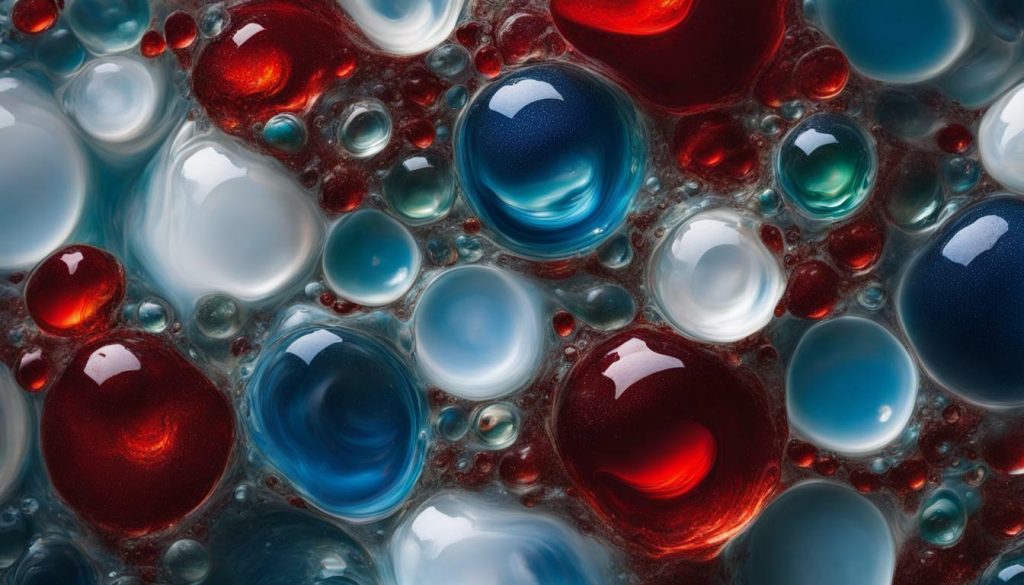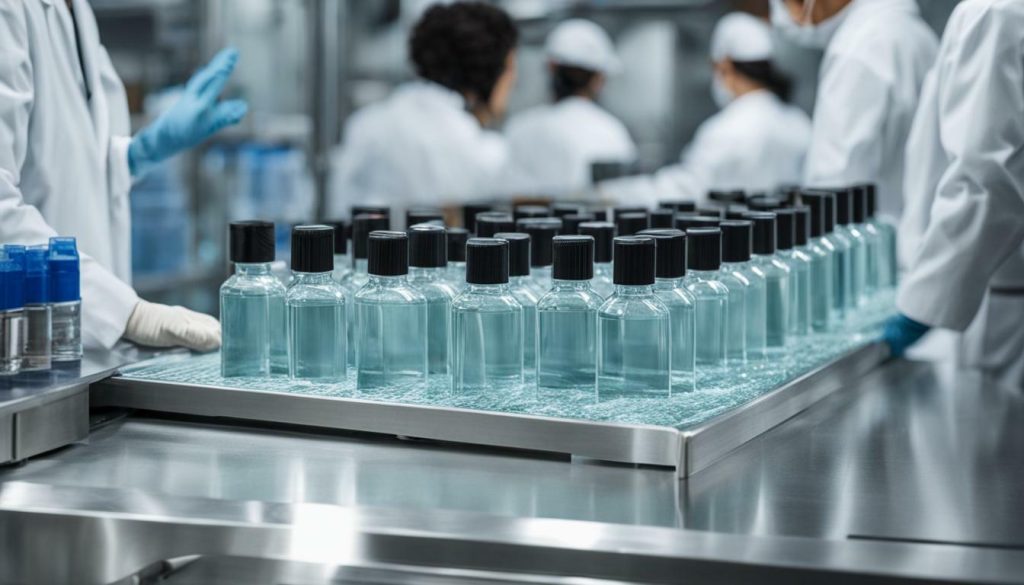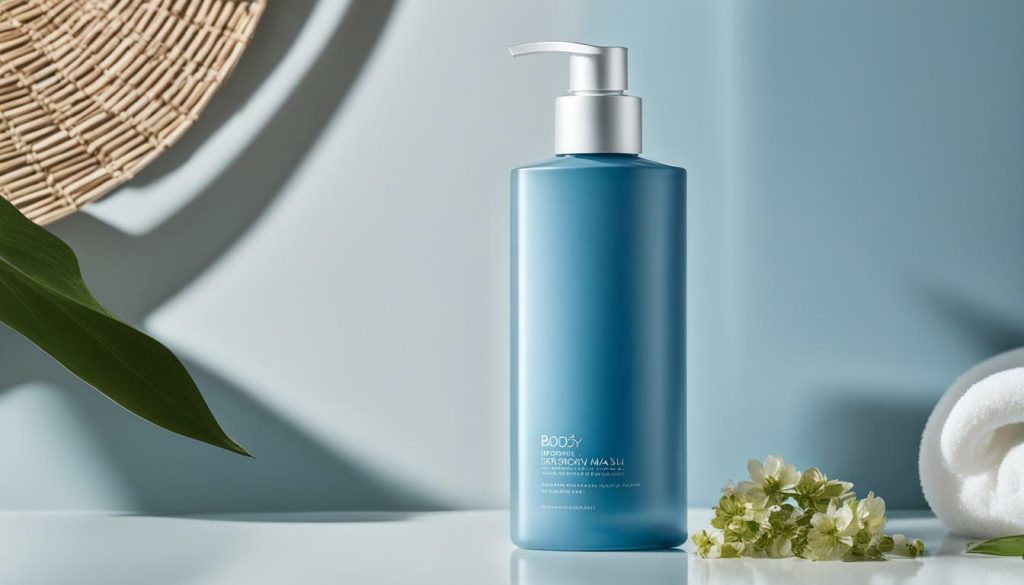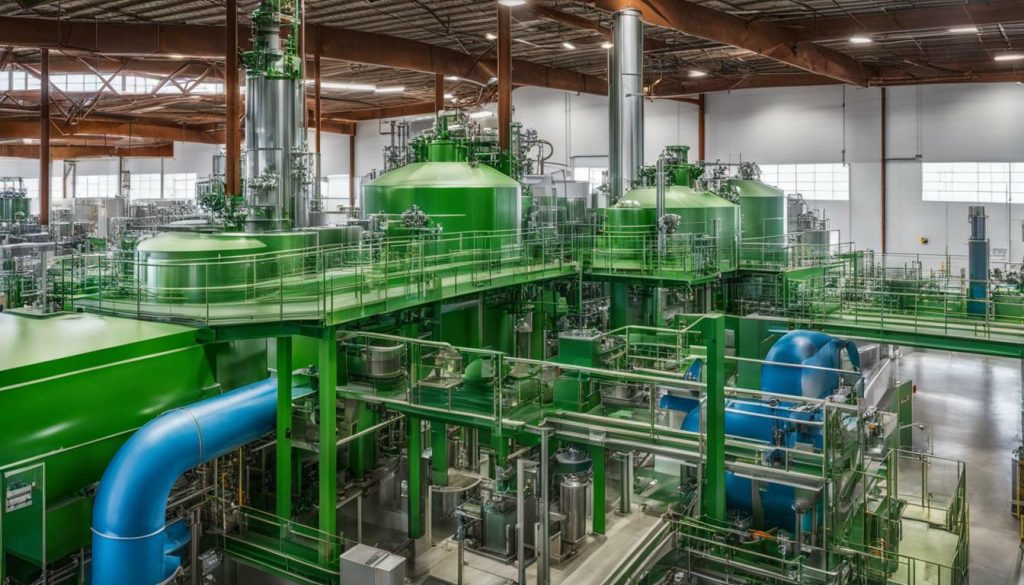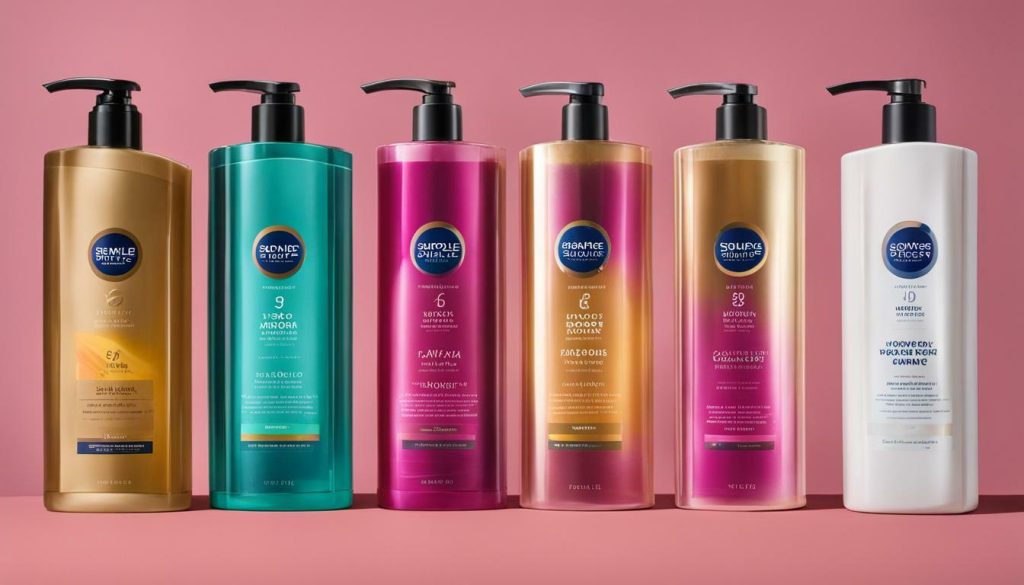Body wash is an everyday essential that most of us use without giving much thought to its production. However, the process of making body wash is complex, involving numerous steps and ingredients that contribute to its effectiveness and functionality. In this article, we will provide an in-depth look at the manufacturing process of body wash and the key ingredients used.
- Body wash production involves various ingredients and steps that ensure product effectiveness.
- Surfactants and emulsifiers are essential ingredients that help remove dirt and oil from the skin and blend water and oil-based ingredients together.
- Additives, fragrances, and quality control measures ensure body wash is safe, effective, and appealing to consumers.
- Sustainability and eco-friendliness are growing concerns in the industry, with manufacturers implementing eco-friendly practices in their production processes.
- Market insights and consumer preferences are key factors that influence the production and development of body wash.
Understanding the Basic Ingredients of Body Wash
Body wash is a liquid soap used to cleanse the skin while taking a shower or a bath. It comprises a combination of synthetic and natural ingredients, each performing a specific function. Understanding the components of body wash can help you in choosing a product that suits your skin type.
Some of the basic ingredients in body wash include surfactants, moisturizers, fragrances and additives, and preservatives. These ingredients work together to ensure that the body wash is effective in cleansing the skin while keeping it moisturized.
Surfactants
Surfactants are the primary cleansing agents in body wash, responsible for removing dirt, oil, and impurities from the skin. They work by reducing the surface tension of water, allowing it to penetrate and dissolve dirt and oil particles. The most common surfactants in body wash include sodium lauryl sulfate, sodium laureth sulfate, and cocamidopropyl betaine.
While surfactants are essential in body wash, they can also strip the skin of natural oils, leading to dryness and irritation. Many companies now use mild surfactants that are gentle on the skin while still effectively cleansing it.
Moisturizers are added to body wash to help counteract the drying effect of surfactants. They help to maintain the skin’s natural moisture barrier, keeping it soft and smooth. Some common moisturizers found in body washes include glycerin, aloe vera, and shea butter.
Fragrances and Additives
Fragrances and additives are used to enhance the sensory experience of using body wash. They include a wide range of ingredients, such as essential oils, extracts, and dyes. Many body washes use synthetic fragrances to create a pleasant scent that lasts throughout the day.
Preservatives
Preservatives are added to body wash to prevent the growth of bacteria and fungi. They help to extend the shelf life of the product and keep it safe for use. Some common preservatives used in body wash include parabens, phenoxyethanol, and benzalkonium chloride.
When selecting a body wash, it is important to consider your skin type and any specific skin concerns you may have. Look for products that contain mild surfactants and moisturizing ingredients to keep your skin healthy and hydrated.
The Role of Surfactants in Body Wash Production
Surfactants are the key cleansing agents used in body wash production. These compounds are designed to remove dirt and oil from the skin, leaving it clean and refreshed.
The surfactants used in body wash come in different varieties, each with its unique properties and benefits. Anionic surfactants like sodium lauryl sulfate (SLS) are commonly used as they possess excellent cleansing power. However, they can cause skin irritation, especially for people with sensitive skin.
Cationic surfactants, such as benzalkonium chloride, are milder and often used in conditioning body wash. Non-ionic surfactants, such as cocamidopropyl betaine, are used in milder formulations as they do not have an electrical charge and are less likely to cause skin irritation.
Typically, body wash formulations contain a combination of surfactants to maximize their performance while minimizing adverse effects.
The key to achieving a successful body wash formulation lies in getting the surfactant balance right. The surfactants must be carefully selected, mixed, and formulated to ensure optimal cleansing power, efficacy, and safety.
In addition to their primary cleansing function, some surfactants also possess secondary benefits, such as emulsifying, foaming, and thickening properties. These properties aid in achieving the desired texture, viscosity, and sensory experience of the final product.
It should be noted that while surfactants are essential components of body wash, they can have adverse environmental effects. Some surfactants are non-biodegradable and can accumulate in water bodies, leading to pollution and harm to aquatic life.
The Importance of Choosing the Right Surfactants in Body Wash Production
Choosing the right surfactants is crucial in body wash production. Not only does it impact the performance and safety of the final product, but it also affects its cost-effectiveness and marketability.
Manufacturers must consider several factors when selecting surfactants, such as their cleansing power, compatibility with other ingredients, and environmental impact. They must also ensure that the chosen surfactants meet regulatory standards and guidelines.
In conclusion, surfactants are crucial components of body wash production. Their selection, formulation, and balance significantly impact the efficacy, safety, and marketability of the final product. As a consumer, being aware of surfactants’ role in body wash can help you make informed choices that align with your values and preferences.
The Function of Emulsifiers in Body Wash
Emulsifiers are crucial components in the production of body wash. These emulsifying agents are responsible for creating a stable and homogeneous formulation by blending oil and water-based ingredients together. Without emulsifiers, the ingredients in body wash would separate and leave an unappealing texture and appearance.
Emulsifiers have both hydrophilic and lipophilic properties, allowing them to interact with both water and oil. They work by surrounding oil droplets with their hydrophilic ends, while their lipophilic ends stay in contact with the oil. This helps to evenly distribute oil-based ingredients in the water-based formula, creating a consistent texture that is easy to apply and rinse off.
In addition to improving the texture of body wash, emulsifiers can also enhance the performance of other ingredients. For example, they can increase the cleansing power of surfactants and improve the moisturizing properties of humectants.
There are several types of emulsifiers used in body wash, including glyceryl stearate, PEG-100 Stearate, and ceteareth-20. Each type has its unique properties that affect how it functions in the formula. Manufacturers must carefully consider the emulsifying agent they use in their products to ensure optimal performance and stability.
Fragrances and Additives in Body Wash
Have you ever wondered why your body wash smells so good? The answer lies in the fragrances and additives used in its formulation. These ingredients enhance the sensory experience of using body wash and can even provide additional skin benefits.
Fragrances in body wash can range from floral to musky, and everything in between. They are typically added in small amounts to provide a pleasant scent that lingers on the skin after washing. You may see fragrances listed on the ingredient label as “parfum” or “fragrance.”
In addition to fragrances, body wash may contain other additives that improve its performance. For example, moisturizing agents like glycerin or shea butter can help hydrate and soften the skin. Vitamins and antioxidants, such as vitamin E or green tea extract, can provide nourishment and protect against environmental stressors.
Some body washes may also contain exfoliants, such as crushed walnut shells or sugar, which help slough off dead skin cells and leave the skin feeling renewed and refreshed.
Choosing the Right Body Wash for You
When selecting a body wash, it’s important to consider your individual skin needs and preferences. If you have dry skin, look for a body wash that contains moisturizing ingredients. If you prefer a particular scent, opt for a body wash with a fragrance that appeals to you.
However, be mindful of potential irritants or allergens. Fragrances and certain additives can cause skin reactions in some individuals, so if you have sensitive skin, look for fragrance-free or hypoallergenic options.
Ultimately, the choice of body wash comes down to personal preference. With a variety of fragrances and additives available, there is a body wash out there for everyone.
The Manufacturing Process of Body Wash
Body wash production involves several steps to create a high-quality, effective product. The process typically begins with the preparation of the ingredients, which are carefully measured and blended to form a precise formula.
The specific production steps may vary depending on the manufacturer and the intended product characteristics. However, the following are some of the common steps involved in the manufacturing process of body wash:
Mixing
The first step is to mix the ingredients in the correct proportions. This is usually done in a large mixing tank, using specialized equipment that ensures thorough blending of the ingredients. The mixing process can take anywhere from a few minutes to several hours, depending on the viscosity of the ingredients and the desired consistency of the final product.
Heating and Cooling
Some ingredients may need to be heated or cooled during the production process to achieve the desired consistency or texture. For example, emulsifiers are often heated to dissolve them in water before they are added to the formula. Cooling may also be required to solidify the product, making it easier to package.
Testing
Throughout the production process, manufacturers conduct quality control tests to ensure that the product meets the required standards. These tests may include pH testing, viscosity testing, and microbial testing to ensure that the product is safe for use and free from contamination.
Filling and Packaging
Once the body wash has been mixed and tested, it is ready to be filled into bottles or other containers. Filling is typically done using specialized equipment that ensures precise measurements and reduces waste. The containers are then sealed and labeled with important information, such as the ingredients, usage instructions, and expiration date.
The production steps for body wash require careful attention to detail and strict quality control measures to ensure that the final product is safe, effective, and appealing to consumers.
Quality Control Measures in Body Wash Production
Ensuring product quality is a top priority for body wash manufacturers. From the initial ingredient selection to the final packaging, multiple quality control measures must be taken to ensure consistency, safety, and effectiveness.
The first step in quality control is to establish a standard recipe and manufacturing process. Manufacturers carefully select and test the ingredients to ensure they meet quality standards and are safe for use on the skin. Once a recipe is finalized, the manufacturing process is tested and refined until it consistently produces the desired result.
Throughout the production process, various quality control tests are conducted to ensure the product meets the established standards. These tests may include pH testing, viscosity testing, and microbial testing to ensure the product is safe for use and has a consistent texture and performance.
Before the product is released to the market, extensive testing is conducted to ensure it meets regulatory guidelines and consumer expectations. This may include testing for skin irritation, stability, and shelf life.
Quality control measures also extend to the packaging and labeling of the product. Manufacturers must ensure that the packaging is secure, durable, and tamper-proof, and that the labeling adheres to regulatory requirements. This includes providing clear and accurate information about the ingredients, intended use, and any warnings or precautions.
By implementing rigorous quality control measures, body wash manufacturers can ensure that their products are safe, effective, and consistent in quality. As a consumer, you can have confidence in the quality of the body wash products you use.
When it comes to packaging and labeling body wash, there are several regulations that manufacturers must follow to ensure product safety and accurate information for consumers. The packaging should be designed to protect the product from damage, contamination, and deterioration during transportation and storage. It should also be easy to use and dispose of in an environmentally-friendly manner.
In terms of labeling, the product must include information such as the name and address of the manufacturer, the product’s net weight or volume, and a list of ingredients. The labeling should also include any warnings or precautions, such as avoiding contact with eyes, and instructions for use.
The Food and Drug Administration (FDA) requires that all cosmetic products, including body wash, comply with their labeling guidelines. This means that manufacturers must ensure that all claims made on the label are truthful, not misleading, and substantiated by scientific evidence. They must also avoid using language that implies the product has medical benefits or can cure specific skin conditions.
When designing packaging and labeling for body wash, manufacturers must also consider sustainability. Eco-friendly options such as recycled packaging and biodegradable materials are becoming increasingly popular among environmentally conscious consumers.
By adhering to packaging and labeling requirements and considering environmental impact, manufacturers can ensure that their body wash products are safe, accurate, and sustainable.
Sustainability in Body Wash Production
As consumers become more environmentally conscious, the body wash industry is taking note and adopting eco-friendly practices in manufacturing. Sustainability has become a top priority in every aspect of the process, from ingredient sourcing to packaging design.
Manufacturers are now opting for renewable and biodegradable ingredients that are both effective and gentle on the environment. Additionally, sustainable farming practices such as organic and fair trade sourcing are being implemented to ensure ethical and responsible production.
One of the most significant steps taken towards eco-friendly body wash manufacturing is the use of recycled materials for packaging. By utilizing recycled plastics, manufacturers can reduce waste and provide a more sustainable solution for consumers.
Energy efficiency is another critical factor in the production of body wash. Implementing energy-saving protocols, such as using solar panels and minimizing water usage, can significantly reduce a manufacturer’s carbon footprint.
Overall, the shift towards sustainability in body wash production is a testament to the industry’s commitment to responsible and ethical manufacturing practices.
The Future of Body Wash Manufacturing
The body wash industry is constantly evolving, with manufacturers seeking to innovate and improve their products to meet changing consumer demands. The future of body wash manufacturing is shaped by various factors, including emerging ingredient technologies, sustainability concerns, and consumer preferences.
One of the evolving trends in body wash production is the use of natural and organic ingredients. Consumers are becoming increasingly conscious about the products they use on their bodies, and are seeking out more natural and eco-friendly options. As a result, many manufacturers are incorporating plant-based ingredients, such as aloe vera and essential oils, into their formulations.
The future of body wash manufacturing also includes advancements in packaging design. Manufacturers are exploring new materials and designs that are more eco-friendly and sustainable, such as biodegradable packaging and refillable containers. This shift towards sustainable packaging not only benefits the environment, but also provides cost savings for manufacturers and consumers alike.
Additionally, consumer preferences are playing a significant role in shaping the future of body wash manufacturing. Fragrance choices and ingredient preferences continue to be important factors for consumers, with many opting for unique and exotic scents and ingredients. Manufacturers are also incorporating innovative technologies, such as microencapsulation, to enhance the sensory experience of using body wash.
Overall, the future of body wash manufacturing is focused on sustainability, innovation, and meeting the diverse needs and preferences of consumers. By keeping up with evolving trends and staying at the forefront of innovation, manufacturers can continue to produce high-quality body wash products that meet the evolving needs of consumers.
Market Insights and Consumer Preferences for Body Wash
As the demand for personal care products continues to grow, so does the body wash market. One major trend in the industry is the increasing consumer preference for natural and organic ingredients. Many consumers are now looking for body washes that are free from harmful chemicals, such as sulfates and parabens, making ingredient transparency and product claims critical factors in purchasing decisions.
Fragrance is also a significant factor in the body wash market. Consumers are drawn towards scents that evoke relaxation and comfort, such as lavender and eucalyptus. However, there is also a growing demand for more unique and exotic fragrances, such as patchouli and sandalwood.
Another trend in the body wash market is the desire for multi-functional products. Consumers are now looking for body washes that can also moisturize and exfoliate the skin, eliminating the need for separate products. This demand has led to the development of body washes that contain added moisturizers, including shea butter and jojoba oil, and exfoliating agents such as salicylic acid and glycolic acid.
The COVID-19 pandemic has also had a significant impact on the body wash market. With increased emphasis on hygiene and hand-washing, many consumers are now looking for body washes with anti-bacterial properties. This has resulted in a surge in demand for body washes containing tea tree oil and other natural antibacterial agents.
As consumer preferences continue to evolve, manufacturers must remain mindful of changing trends and adapt to meet the demand for safer, more natural, and multi-functional body washes. With sustainability, transparency, and efficacy becoming increasingly important for consumers, the body wash market is sure to see continued growth and innovation in the years to come.
Conclusion
Now that you have a comprehensive understanding of the manufacturing process that goes into creating body wash, you can make informed choices when selecting the most suitable product for your personal needs. By familiarizing yourself with the basic ingredients, cleansing agents, and emulsifiers found in body wash, you can choose a formulation that aligns with your skin type and specific preferences.
It’s worth noting that the manufacturing process of body wash involves rigorous quality control measures that ensure consistency, safety, and effectiveness. Regulatory guidelines and packaging requirements are also in place to provide consumers with clear and accurate product information.
As the industry continues to evolve, it’s exciting to see the emerging trends and innovations in the field of body wash manufacturing. Eco-friendly practices and advancements in ingredient technology are shaping the future of the industry, and consumer preferences are driving demand for more customized and specialized products.
By staying up-to-date with market insights and consumer preferences, manufacturers can continue to meet the evolving needs of consumers and provide high-quality body wash products that promote healthy and radiant skin.

Hey there! I’m Dr. Mary Noland, your trusted authority in dermatology. My 17-year rollercoaster ride in skin science has been nothing short of a masterclass. Whether you’re a newbie or a familiar face, I’m here with open arms and Medicare-friendly services, dedicated to creating your perfect skin haven.
But hold up! There’s more to me. When I’m not elbow-deep in dermatology, I’m lighting up derma blogs with insights that peel back the layers of skin health. Also, as the proud captain of ‘buybodywash.com‘, I provide all the body care goodness you need!
Trust me; I’m more than just a white coat. I’m here to lend an ear, share a laugh, and bring calm with a reassuring voice that’s comforted countless patients.
So, meet Dr. Mary Noland – your dermatologist and your guide and friend on the path to radiant skin. I am excited to meet you soon!

